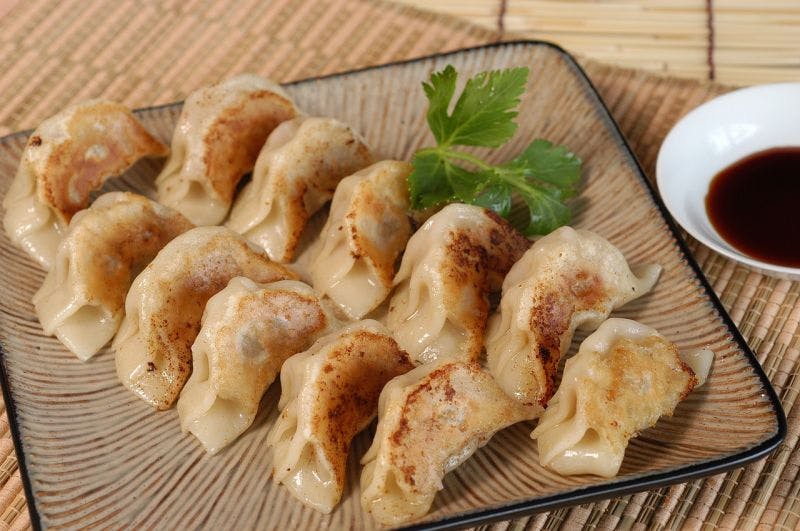your cart
Your cart is empty.
General Articles
Guide to Gyoza
Gyoza are a type of dumpling enjoyed in Japan which are typically filled with meat and vegetables and fried. Gyoza are commonly eaten simply with a dipping sauce. As well as being fried, these dumplings can be steamed or boiled for a different texture. There are several different types of gyoza eaten in Japan, each with slight variations in ingredients and cooking style. We take a look at the different types, and how gyoza have become so popular in Japan!

Gyoza are a type of dumpling enjoyed in Japan which are typically filled with meat and vegetables and fried. Gyoza are commonly eaten simply with a dipping sauce. As well as being fried, these dumplings can be steamed or boiled for a different texture. There are several different types of gyoza eaten in Japan, each with slight variations in ingredients and cooking style. We take a look at the different types, and how gyoza have become so popular in Japan!
History of Gyoza
Dumplings have been enjoyed in Japan since the Edo period; however, they only truly gained the popularity they have today following the Second World War. During the war, many Japanese soldiers had been living in China. When they returned to Japan, missing the tastes of Chinese cuisine, the dumpling was recreated back home. While looking similar to the Chinese dumpling, the tastes were developed to better suit the flavours most enjoyed in Japan.
Gyoza are based on Chinese potstickers, known as jiaozi, with the word ‘gyoza’ coming from ‘jiaozi’. Chinese dumplings tend to be a little thicker and doughier than Japanese dumplings, which feature a much thinner wrapper. They were created in Japan with a thinner wrapper so that they could be fried easier on a teppanyaki grill.
Varieties of Gyoza
Yaki-Gyoza
Perhaps the most popular form of gyoza, these are most similar to the Chinese potstickers. The yaki-gyoza is first pan-fried before water is added to the pan and covered with a lid, allowing the gyoza to steam and boil, fully cooking the ingredients within. Before serving, the lid is removed, and the gyoza are crisped up on the pan once more, forming a tender dumpling with a crispy wrapper.
Age-Gyoza
Age-gyoza are similar to yaki-gyoza, except, instead of being cooked in a pan, they are deep-fried. This affords them a much crispier wrapper, providing a big crunch with every bite! Be careful when eating, though, as they are served fresh from the fryer and will be hot!
Sui-Gyoza
Different to yaki-gyoza and age-gyoza, sui-gyoza are boiled rather than fried. They can be boiled in a broth to give them extra flavour. This cooking method provides the gyoza with a much chewier, yet tender texture. These may be served in a small amount of soup, or drizzled with a ponzu dressing.
Mushi-Gyoza
Another alternative to fried dumplings comes in the form of mushi-gyoza, or steamed gyoza. These dumplings are prepared in a bamboo steamer, like Chinese dim sum dumplings.
Common Ingredients
As well as dumpling type and cooking method, the ingredients found within the gyoza are also important. Traditionally, a Japanese gyoza would be filled with minced pork, shiitake mushrooms and shredded cabbage, providing the perfect blend of flavour and texture. More unusual, but equally popular fillings could include seafood, such as minced prawn or sea urchin, fermented soybeans, cheese or tofu.
Alongside the ingredients for the gyoza themselves, several condiments will also be needed to create the perfect sauce to dip these dumplings into. Commonly, soy sauce, sesame oil, vinegar, chilli oil and garlic will be provided alongside gyoza so that you can create a dip to suit your tastes and the flavours present in your chosen gyoza! Alternatively, many restaurants and Japanese supermarkets will offer their own gyoza dipping sauce.
Here at Oriental Mart, we have a wide range of frozen gyoza and other Japanese snacks available online and in our store. Check out our range, or take a look at our blog for more Japanese cuisine inspiration.
this site uses cookies
We and our advertising partners use cookies on this site and around the web to improve your website experience and provide you with personalised advertising from this site and other advertisers. By clicking allow, you accept the placement and use of these cookies for these purposes. Learn More


